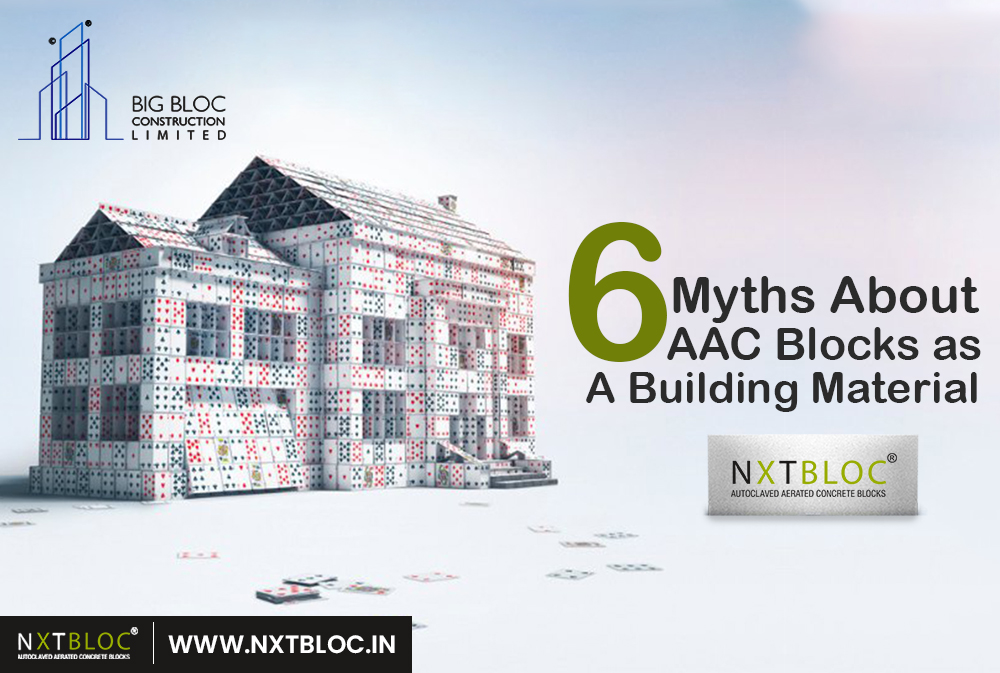Autoclaved aerated concrete blocks, or AAC blocs, are a relatively new building material. This means that many people are unfamiliar with them and have misconceptions about them—and this is especially true for builders.
Do you know how to distinguish between true and false statements about aerated concrete?
Let’s see if we can figure out which common claims about autoclaved aerated concrete are unfounded and caused by insufficient customer information or non-compliance with the technology of constructing houses from AAC blocks.
Myth 1: The presence of aluminium in AAC blocks is harmful to health.
- Aluminium powder is the essential ingredient used in foaming solutions used in the production of AAC blocks.
- When aluminium reacts with lime, hydrogen is released and many gas-filled cells are formed. These provide the unique characteristics of these blocks.
- Though aluminium, in pure form, cannot be preserved in the composition of the material.
- When the reaction with lime is complete, the remaining substance is a stable chemical compound called aluminium oxide. Clay and ceramic bricks are also made from this substance.
Myth 2: AAC Blocks are a fragile material that contains cracks.
“Fragility” is a term that is not used in the construction industry. The origin of this myth is not hard to understand. A lot of customers turned to unscrupulous builders and faced damage and cracks during the transportation of AAC blocks, or in their walls. But in most cases, such problems are associated with not following instructions on how to use aerated concrete.
- When working with wall materials, it’s important to understand the carrying capacity of Autoclaved Aerated concrete blocks and the material’s ultimate strength for compression, stretching, bending, etc.
- The bearing capacity of the most popular brands of brick blocks meets the requirements necessary for the construction of houses.
- Cracks can still occur in houses made from brick blocks due to non-observance of construction technology—incorrect laying of foundations, lack of reinforcement, and use of grades of aerated concrete that don’t comply with calculations.
Myth 3: Paving AAC blocks with adhesives are expensive and thus not profitable.
This statement is refuted by a number of simple calculations.
- The cost of a thin-layer glue mixture is higher than that of ordinary cement by 2 to 2.5 times.
- The laying of elements on the cement-sand mixture requires the formation of joints at least 10 mm thick, but in thin-layered glue composition, the seam thickness is 1-3 mm.
- If a thin-layer mixture is used during the construction of a house, it will consume 5-6 times less than a cement one.
Myth 4: When AAC Blocks are exposed to water, it rapidly loses their durability.
The cause of this myth is also a consequence of errors made during the construction.
- Most building materials are hygroscopic and vapour-permeable to some degree, but this does not prevent us from using them in the construction of buildings. For example, a tree.
- The material of brick blocks should be protected from direct exposure to water: cover it with oilcloth on the construction site to protect it from rain, and protect it from moisture coming up from the ground.
- In other respects, worries about the soaking of aerated concrete are unfounded.
- Due to the high vapour permeability of aerated concrete walls in heated rooms, moisture evaporates quickly.
- Furthermore, it is possible to judge that AAC constructed properties are being restored after a flood.
- But if the outside wall is covered with a finish that is not permeable to moisture, moisture will accumulate inside the wall blocks.
Myth 5: Brick blocks require insulation, which is mandatory.
The thickness of the walls of a house built with or without insulation will vary depending on the building material. For example, insulated frame houses have walls 15 centimetres thick, while reinforced concrete homes have walls several meters thick.
For example, to properly insulate a brick house with a width of 1.5 bricks (38 cm), you would need to use a 15-cm layer of thermal insulation.
When aerated concrete is used to build walls, the thickness of the wall and the need for a heater are determined by a heat engineering calculation.
In colder regions, the minimum thickness of a concrete-block wall without insulation is 35 cm; however, such a wall can be made warmer by using blocks with a width of 20-25 cm and an insulating layer of 10-15 cm.
Myth 6: Autoclaved Aerated concrete requires expensive finishing to look good.
- Facial bricks or facade panels cover aerated concrete walls, but they do so for aesthetic reasons and not for protection against atmospheric influences.
- Autoclaved Aerated concrete bricks dry quickly when exposed to rain or snow.
- If you want to save brick blocks, you can paint or plaster the walls with a material that has high vapour permeability. Or you can leave them bare without finishing them.
- While protecting the walls from moisture, it is still essential to properly equip the window and roofing overhangs of the cottage.
Conclusion
NXTBloc is one of India’s leading AAC block suppliers, manufacturers and exporters. We are pleased to introduce ourselves to your esteemed organization, which uses Autoclaved Aerated concrete blocks for construction projects and would like to explore the possibility of purchasing our exclusive range of AAC Blocks.
